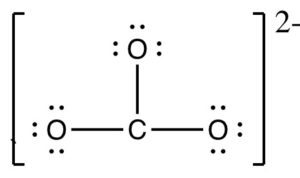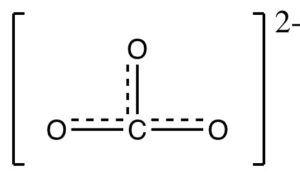One issue arises when drawing the Lewis structures of some molecules and polyatomic ions. If we draw a Lewis structure for the carbonate ion, CO32-, the number of valence electrons is 24 electrons. We add two electrons because of the -2 charge on the ion. The skeletal structure is below.
We see the three oxygens have octets but the carbon does not have an octet. We can move a pair of electrons from one of the oxygens to form a carbon-oxygen double bond. But, which oxygen? In fact we can draw three different structures. These are called resonance structures or resonance contributors. The atoms are all connected in the same way, the only difference in the structures is the location of the lone pair of electrons.
The actual structure is an average of the three resonance structures — a resonance hybrid. The electrons are delocalized about all of the atoms. There are no single and double bonds. In fact, all of the bonds are equivalent in size and strength. They are somewhere between a single and double bond. The hybrid structure is shown below.
The dashed lines show the electrons are delocalized. In fact the -2 charge is shared among the 3 oxygen atoms. Each oxygen atom has a charge of -2/3. Electron delocalization stabilizes a molecule or an ion. In the case of carbonate ion, there are three carbon-oxygen bonds, and each resonance contributor contributes equally to the resonance hybrid structure. In a later study guide, Formal Charges, we will see there are ions and molecules that have only one important resonance contributor.
Curved arrows are used to show electron movement. The tail of the arrow indicates the electrons and the arrowhead indicates where the electrons are moved. Electrons can be moved from a multiple bond to an atom or they can be moved to an electron poor species. In the figure below, a pair of electrons is being moved from one oxygen to form a bond with carbon, and another pair of electrons are moved from the double bond back to the oxygen atom.
This is just an introduction to curved arrows, but they are used extensively in Organic Chemistry. A book that I highly recommend is called Pushing Electrons by Daniel Weeks. If you understand how to push electrons, you will do very well in organic chemistry.
Exercises
Exercise 1. Draw a Lewis stucture for ozone, O3. Draw any resonance structures, use curved arrows to show the movement of electrons, and draw a hybrid structure.
Exercise 2. Draw the resonance structures for the nitrate ion, NO3– and draw a hybrid structure.
Exercise 3. Draw any possible resonance structures for SO2. Use curved arrows to show the movement of electrons.
Check Solutions/Answers to Exercises
Back to Covalent Bonds and Lewis Dot Structures
Back to General Chemistry 1 Study Guides
Back to Home Page




